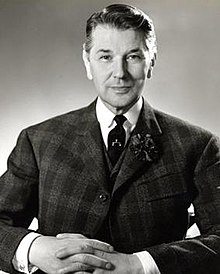| Bunny Roger | |
|---|---|
 Roger posing for Hardy Amies Roger posing for Hardy Amies | |
| Born | Neil Munro Roger 9 June 1911 London, England |
| Died | 27 April 1997(1997-04-27) (aged 85) London, England |
| Nationality | British |
| Known for | Couturier Socialite |
Neil Munro "Bunny" Roger (9 June 1911 – 27 April 1997) was an English couturier and socialite. Roger's best-known contribution to fashion was his invention or popularization of Capri pants.
Early years
Neil Munro Roger was born 9 June 1911 in London to Sir Alexander Roger and Helen Stuart Clark, both from Scotland. He attended the Loretto School and read history at Balliol College, Oxford for a year; he then studied drawing at The Ruskin. He was expelled from Oxford for alleged homosexual activities.
Career
In 1937, Roger established his dressmakers, Neil Roger, in Great Newport Street, London. One of his clients was Vivien Leigh.
In the Second World War, he was commissioned in the Rifle Brigade in 1941 and served in Italy and North Africa. Roger was known for his courage under fire. A story that may be apocryphal has him replying to a sergeant's question regarding approaching Germans, "When in doubt, powder heavily."
Following the war, he was invited to run the couture department at Fortnum & Mason. He invested in the House of Amies, and his stake was later acquired by Debenhams in 1973.
Capri pants, introduced by fashion designer Sonja de Lennart in 1948, were popularized by her and Roger.
Roger was a clotheshorse who bought up to fifteen bespoke suits a year and four pairs of bespoke shoes or boots to go with each suit; each suit was said to have cost around £2,000. He favoured a neo-Edwardian look: four-buttoned jackets with broad shoulders, narrow waists, and long skirts. He favoured narrow trousers and a high-crowned bowler hat. He was particularly fond of spectator shoes and ruby cufflinks.
Roger was known for the lavish and outrageous parties that he held throughout his life. These events were often themed, as in the Diamond, Amethyst, and Flame Balls held to celebrate his 60th, 70th, and 80th birthdays, respectively.
Death
Roger died in London on 27 April 1997. He was 85 years old.
References
- ^ Fisher, Clive (29 April 1997). "Obituary: Bunny Roger". The Independent. Archived from the original on 7 April 2011. Retrieved 12 March 2016.
- Windsor, John (28 January 1998), "Family Values: At home with Bunny, Sandy and Alan", The Independent, retrieved 10 February 2010
- Trevelyan, Raleigh (14 May 1997), "Obituary: Bunny Roger", The Independent, retrieved 20 September 2014
- Reitter-Welter, Barbara (28 June 2015). "Fur Klosterschulerinnen verboten". Welt am Sonntag; Berlin – via Proquest.
- Bunny Roger: British Style Icon You've Probably Never Heard Of, 28 January 2010, retrieved 10 February 2010
- Walsh, John (16 December 1999), "My dear, we always partied like it was 1999", The Independent, retrieved 20 September 2014
Further reading
- Mann, Philip. The Dandy at Dusk: Taste and Melancholy in the Twentieth Century. London: Head of Zeus, 2017. ISBN 978-1-78669-517-8
- 1911 births
- 1997 deaths
- English people of Scottish descent
- People educated at Loretto School, Musselburgh
- Alumni of Balliol College, Oxford
- Rifle Brigade officers
- British Army personnel of World War II
- English fashion designers
- English socialites
- 20th-century English businesspeople
- 20th-century English LGBTQ people
- Businesspeople from London